Media | Articles
My garage needs a workbench, but where?
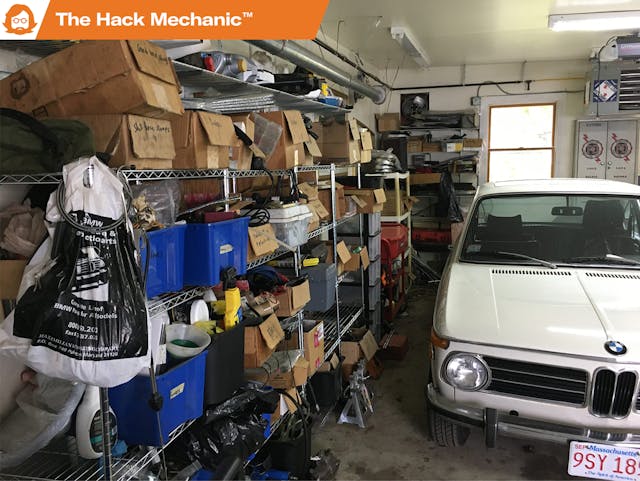
My garage is attached to the back corner of my house, as that was the only way to build it and respect the town’s requirement of a four-foot setback from the property line. Its 31- x 17-foot size was the maximum allowable under a different building code that puts a limit on the ratio of the home’s square footage to that of the property. The garage’s low ceiling, which precludes having a real walk-under post lift, is due to the fact that a high ceiling would’ve obstructed the view out the dining room window.
In other words, the garage is a compromise solution that navigated a number of obstacles on its way to fruition. It is a triumph of the good over the perfect. From the suburban streets of Newton, Massachusetts, you don’t see the garage at all. From the backyard, it sticks out like an ovipositor on the butt of a wasp.

Although I love my garage and am blessed to have it, there are a number of issues with it. All access is through a single roll-up door at the front. There’s a double-width roll-up door on the rear side, intended to allow a big hooked J-turn into the garage and put one car cross-wise in the back, but I’ve never used it that way. Instead, even though we didn’t design it for this, I discovered early on that, since most of my vintage cars are short (a BMW 2002 is a little under 14 feet), I can fit two of them straight-in nose-to-tail, obviating the need for the awkward car-crosswise-in-the-rear thing. I back a third car in, do a dog-leg turn, and put it in the left rear of the garage. This fits three cars and leaves an empty space on the front left.
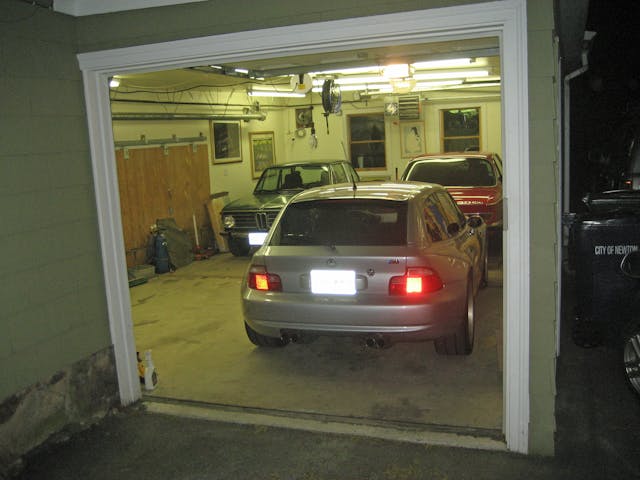
I can and have squeezed a fourth car in there by sliding it sideways on wheel dollies, but \for several reasons I haven’t done so in a few years. It takes a bit of work to pull off the maneuver. The floor slopes slightly toward the back for drainage, which means that a car on roller dollies will tend to drift rearward. To stop it, I have a wooden runner screwed into the floor, but the wheels of the roller dollies jam up against it. And with four cars sardined in there, it becomes difficult to get any serious mechanical work done over the winter, as there’s very little room to move. I know I constantly complain about my warehouse storage in Monson, but since it’s expandable, it’s just easier to cap the number of cars in my garage at three.
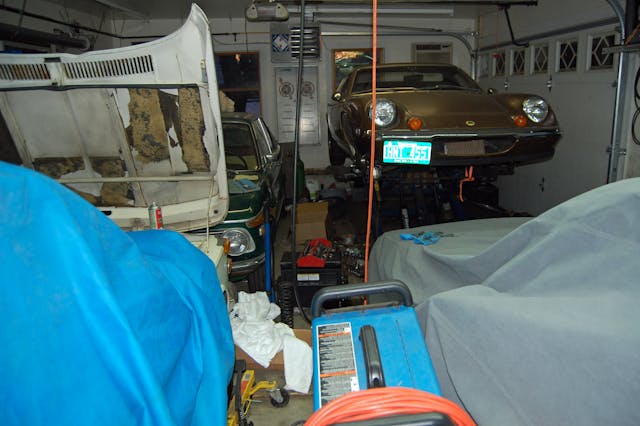
What’s clearly missing in the garage is a workbench to act as both a general-purpose table as well as to hold the bench vise, the table-top grinder, the Scotch-Brite wheel, the band saw, and the drill press that all instead sit on my basement floor. Since I don’t have one, when I’ve needed a work surface, I’ve used a fold-up card table that can barely support the cylinder head I’m working on, much less host a bench vise. Because there’s no broad horizontal work surface, the fourth open space on the garage floor becomes a magnet for, well, everything—tools, new parts I’ve bought that are waiting to be installed, things I’m in the middle of rebuilding, etc. And in order to drive the car that’s in the third space, I need to move all of it.
A separate but overlapping issue is the problem of boxes. For a while, the boxes littering the floor were predominantly full of parts I’ve been gifted from people who’d sold their (or their departed family member’s) BMW 2002, but recently also came to include stuff from selling my mother’s house (I mean, how am I supposed to leave boxes of new light bulbs and painting supplies behind?) and selling my truck (I mean, how am I supposed to leave behind all those tools that were in the truck’s utility body from when it was my geophysics field vehicle?). All of this winds up on the floor in the fourth space along with the welder I never use and the floor jacks.
The fundamental problem is that the garage is just a little too small for the way I try to use it (of course, the fact that I’m a tornado of chaos contributes immensely). I’m thrilled that the garage’s dimensions make it possible to fit three cars and squeeze in four, but it’s challenging to put a workbench inside. There’s zero room along the right wall. There’s barely room along the back part of the left wall. I do have a small parts washer there, but the car in the third space comes within 18 inches of it; I doubt I could put a workbench and a chair there. There’s a door to an under-deck storage closet along the front left wall that I don’t want to block. It’s possible that a bench could go in the left rear, behind the third space, but the floor of that area is still full of stuff.
Now, I’ve tried several times before to do a better job of organizing the garage, but I always lose momentum and fall back to doing the bare minimum that’s necessary to do whatever it was that I really needed to do, which is usually clearing the floor so I can simply get the third car out of the back space and drive it. I decided to take another run at it, this time with the realistic goal of doing enough organization and configuration to keep the fourth space clear so I can pull the car in the third space in and out without making it a floor-clearing project each time, as well as enabling the possibility of a workbench in the back.
If I haven’t made it clear, stuff on the floor is death to efficient use of space not only because it takes up the space on the floor, not only because you can’t drive over it, but because it essentially occupies all the space above it as well—unless it’s stackable crates, little else can be put on top of it. The obvious solution is shelving. Over the decades, I’ve shelved most of the available wall space in both the basement and the garage. Most of this is wire shelving on wall-mounted brackets and standards, but a few years ago I bought two rolling wire shelving units. There’s a sliding door on the left wall that opens up under the back porch where I have big items like the engine hoist stored. By having rolling shelves instead of wall-mounted ones, it allows the possibility (the slim possibility, but the possibility nevertheless) of rolling the shelves out of the way in case I need access to these items. I ordered two more of these rolling shelf units on Amazon and tackled the boxes of junk that were in the way of where I wanted to put them.
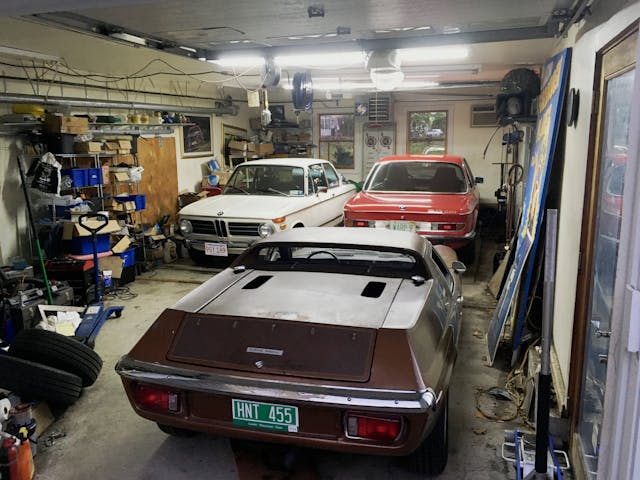
Getting boxes out of the way of where you want to put shelving is definitely a case of things getting much worse before they get better. One by one, I disgorged the contents of boxes (many of which had rotted bottoms) directly onto the garage floor, threw things out, tossed other things in the scrap metal pile, combined like with like, put them in new boxes, and put them up on the shelves.
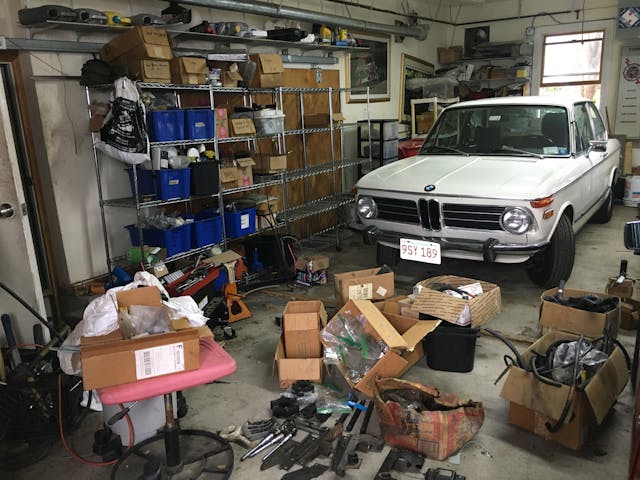
But boy, it’s easy to get sidetracked. I accumulated all the BMW 2002 shift platforms and related transmission and clutch parts left over from when I’d performed five-speed conversions in several cars. I had four shift platforms. Did I need to keep all of them? No. The platform itself is not a rare part that wears out; only the detachable rubber bushings do, and they’re readily available. Still, someone might one to shorten it for a five-speed conversion. Should I give them away? I’ve done a lot of this in the past, and it takes time. I fought my tendency for analysis/paralysis and instead kept two of the good ones and threw the two grimy ones in the scrap metal heap.
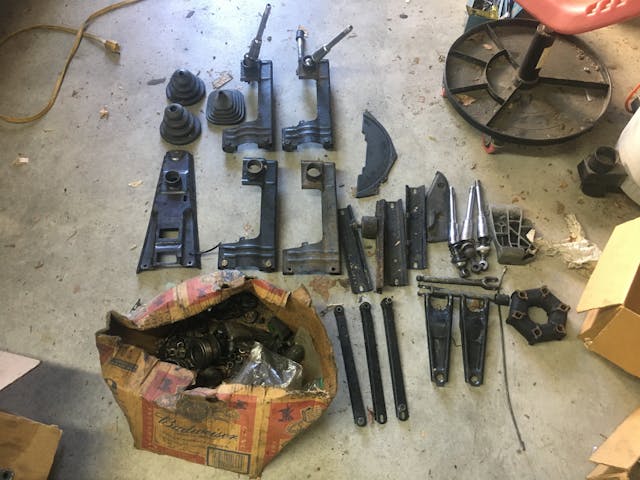
Then I went through the same thing with old cooling system parts. I had seven 2002 thermostats. Granted, there’s some value in saving these things when a) thermostats go bad far less often than we’ve been led to believe, and b) the old ones may be of higher quality than the new ones, but seven? I picked two OE-manufacturer thermostats with low opening temperatures and recycled the rest.
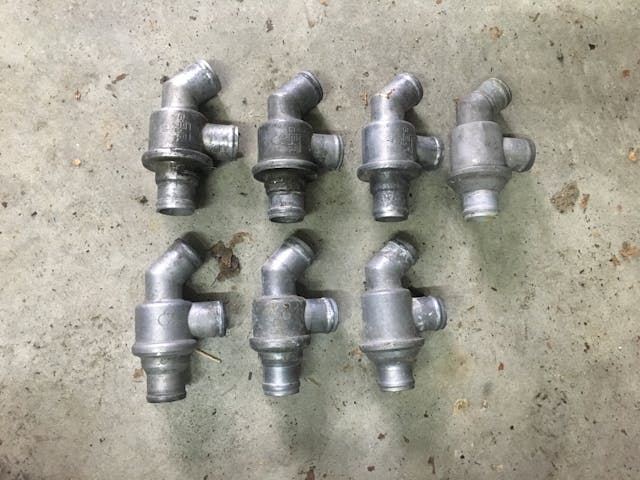
Another issue has been my tendency to keep donated parts together in their original boxes. I’ve been the beneficiary of a number of BMW 2002 parts hoards over the years, several donated by the spouses of their deceased husbands. One fellow was fastidious in his accumulation and bagging of small interior parts. Another had a fine assortment of barely-used under-hood ignition parts that were replaced with higher-performance versions. I’ve kept these collections intact for years, but the time had come to organize by functionality rather than by donor.
If I may continue for a moment longer on the issue of boxes, if the floor is death, boxes are death, too. The problem with boxes is that while they’re necessary for organization and storage, their very presence legitimizes their contents. Just because a box is clearly labeled “Old BMW 2002 ignition parts” doesn’t mean that it isn’t all just junk. A time comes when it’s necessary to dump the contents on the floor, give everything a good hard look, separate the wheat from the chaff, pitch the junk, and redistribute the good stuff. I was particularly merciless with the box of parts from the rebuild of the Lotus Europa’s engine. I mean, used rings, bearings, valves, and timing chain? Out it all went. The edge of silliness of this curve was encountered when I found a box that contained the cleaned-out contents of a car before I sold it. It wasn’t even my car—this was a favor I did for a friend six years ago. So this wasn’t even my stuff. I shredded the old registration and threw the rest away.
In addition to shelving, I have an endless need for drawers and find the plastic multi-drawer storage units very handy. The tall seven-drawer units were a little more expensive on Amazon than I expected, but I found someone on Facebook Marketplace who has a side hustle selling used furniture and delivered one to my house for $45. A few hours and a bunch of plastic take-out containers later, and I had a decently-organized set of drawers with metal and plastic trim clips, small interior screws, zip ties, gaskets, rubber seals and grommets, BMW 2002tii fuel injection parts, and the like.

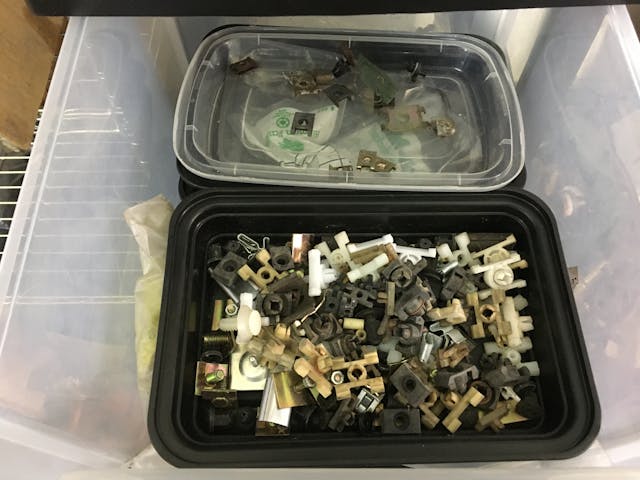
One of the toughest things to deal with has been the tools, as I’ve accumulated redundant sets of them from different sources. The most recent motherlode came from the work truck I just sold—full SAE and metric toolboxes, as well as several ratchet sets in small fold-open plastic cases, were left in it when the truck was largely abandoned when the company I worked for closed the building where it was based. At some point I need to do the full-on anal-retentive organization of, for example, grouping all the ½-inch tall metric sockets together on a socket rail, repeating for all the different socket sizes and types, making one high-quality master tool box, one house tool box, and two road tool boxes, and then taking whatever’s left over down to my local used tool store to sell for pennies on the dollar. But in the meantime, I simply needed this stuff off the floor. My brain and my search patterns were in wire-shelving-mode, so what I found on Amazon was a three-tier wire shelf cart for $80. It does the job. But much of online purchases hinges on using the correct search terms, and in retrospect, looking at “tool carts” would’ve yielded a better solution. Still, several tool boxes and big stuff like sledgehammers and crowbars are now off the ground and roll-able.
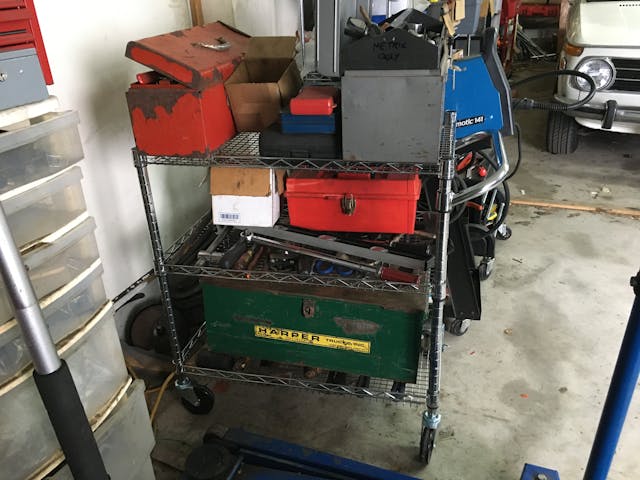
As the garage got way more organized and the fourth space was cleared, the need for a table or workbench made itself known in a funny way. There’s a tall wastebasket in the garage that I’d filled with trash but hadn’t emptied yet. At one point, while dealing with empty boxes I’d slated for recycling, a shallow cardboard tray that originally held a case of carbonated water wound up sitting on top of the wastebasket. Before I knew what had happened, it filled up with stuff—hats, flashlights, T-shirts, a metal box filled with old keys—that I wasn’t sure what to do with. In other words, I began using the first available horizontal surface as a table. “No!” I said to myself. I recycled the box and found longer-term homes for these things or threw them out. As I continued dealing with smaller groupings of stuff—a few electrical components, some molding clips—they naturally found their way onto … other horizonal surfaces, like the tops of toolboxes. The point is that whether you have a table or a workbench or not, one is going to invent itself because the need is never going to go away.
So, no, I don’t have a workbench in the garage yet, but I do now have everything off the floor in the fourth space. I won’t be storing another car in it, but that wasn’t the goal—the goal was making it so I can easily drive the car into space #3. I’m there. Regarding the workbench, I can see light at the end of the tunnel. Once I clean out the stuff behind space #3, I can put a workbench back there.

The only problem is … I sold the truck that I would’ve used to drag home an inexpensive, used work bench.
Damn. Why don’t I ever think these things through?
***
Rob’s latest book, The Best Of The Hack Mechanic™: 35 years of hacks, kluges, and assorted automotive mayhem is available on Amazon here. His other seven books are available here on Amazon, or you can order personally-inscribed copies from Rob’s website, www.robsiegel.com.
Check out the Hagerty Media homepage so you don’t miss a single story, or better yet, bookmark it. To get our best stories delivered right to your inbox, subscribe to our newsletters.
Marketplace
Buy and sell classics with confidence














What a cluster f-rk. Dumpster in, Fill, Dumpster out!
Another workbench solution I have seen is a work surface hooked to the wall with hinges. Fold it down when not in use and raise on fold-able legs for use. Of course, you still have to clear it off to fold it down.
Where’s the challenge in simply filling a dumpster? And I guarantee that you will need at least 3 pieces / parts that were tossed within a week of the tossing.
Same here. My garages have functioned much as yours does. I am now bereft of a garage (my wife wanted our current house so badly that I told her to buy it even though she was ready to let it go on because it has no garage or space to build one). I assumed I could just rent one close by, and eventually I did, but after a few years that fell apart and there are no others available. So now all my tools are in the basement and I am driving modern cars and modern bikes (mainly)… Maybe our next house will have a garage that I can curate to look approximately like the photos in this article!
When we were planning our new barn (which included a shop area), my late wife said to me, “if this is your hobby, you should have a lift”. God, I loved and miss Dorothy. So, the plans were adjusted for an 11 ft space to the base of the trusses. Then lucked out at a previous employer to get a lab bench. 4 x 8, heavy duty construction with three dual outlets on each side. I put it on casters, so can pretty much move it anywhere I need.
I have several benches attached to the walls with hinges and (2)legs on hinges. Fold them up when I need the floor space, fold them down to work on. Yes that simple.
I don’t understand what all you guys are complaining about. The solution is obvious. When I moved from Connecticut to Southwest Florida I designed a home and had it built with a five car garage, 12 foot ceilings and attic storage space so I could house five cars and still have enough space to work on one car (the racecar). When I moved everything in (4 toolboxes, parts, lift, engine crane, etc.) and organized it, I discovered that I have just enough space to store the racecar and nothing else. So the rest sit outside baking in the sun, waiting for the dashboards to dry out and split and the tires to rot. Problem solved?!
I suspect Rob could run out of space in a B17 hangar in under 17 months.
Forget the workbench. It will immediately disappear beneath debris, never to be seen again. (I can send pictures if you’d like proof).
Pardon me for changing the subject but last year you said get back to you regarding bending the float arm to make the sending unit accurate. Well I found a mechanic who agreed it should work if all else is up to snuff and I’m happy to report bending the float arm is a solution to regulating a c4 sending unit.
Glad to hear it!
Not much a help here, but you could put in a stretch of Safe-Rack overhead storage suspended from the ceiling in the #4 spot where there is no garage door interference. Not trying to be a schill here, but I have two 4×8 foot ceiling suspended storage racks in my garage. Each one is length-wise above the 16 x 7 foot garage door on either side of the garage door opener rail. One is offset so access is possible between it and the rail, even with a car in the bay. The other is adjacent to the rail to allow access to the shelving on the wall on the other side (so it’s only accessible with the car out of the bay, though I can lift a few things over the opener rail.) The ceiling is 9′-3″ so there is just enough space vertically for a 13″ space from rack shelf to ceiling above the door (when it’s open). Perfect for storing cases of oil and fluids, spare rims, etc. Supposed to be able to support 400 lbs, so each corner has a mounting rail with four 3″ lag-bolts screwed into the ceiling joists. Even in your location (in the wintertime), the roof should be strong enough to support that.
Rob…A reinforced fold-down just might do the trick.
I have been with my first wife now for over 40 years and during that whole time I have had one rule; “Don’t put your crap in my garage and I won’t put mine in your kitchen”.
It seems like you need a mobile workbench. On the lighter end, Harbor Freight and Home Depot have 18 or 24″ tool chests with wood tops that you can bolt a vise or bench mounted tool to and can moved close to a job, or out of the way to shift cars. At the heavier end in weight and price are Knaack job boxes. It may be worth having two rolling units, one with hand tools and a vise and one with the grinder and drill press
I use a Harbor Freight cabinet and some folding work stands since my garage has no room after the bicycles. kayaks, and motorcycles.
Something like a Black & Decker Workmate, foldable work table? And big hooks to hang it from the ceiling when it’s not in use. (And always hang it up immediately, before you pile on a heap of used ignition parts that you know you won’t ever use again).
That would be a step up from the card table I sometimes use, but it wouldn’t host a vise.
The WorkMate IS a vise .. works well for light and medium duty holding stuff.
This is a battle I am also valiantly fighting.
My space is a detached 26′ deep by 24′ wide, insulated garage. The wife’s car and various things are stored in the single attached garage of the house (this was the compromise made when we bought the property)
In the Canadian winters, I know that I’m at a point where if I can’t work comfortably, I’ll just avoid doing the thing. So I’ve dedicated one bay as the “car” bay (currently housing a 1986 Mercedes 300SDL) and the other bay is the “everything else” bay.
What’s killing my space is one, I have a loveseat (on wheels) and a coffee table made from one of my old engines, they’re positioned to be able to watch the 65″ TV/computer mounted above my L-shaped workbench in the back corner of the “everything else” bay.
Secondly, tire storage, snowblower storage, parts storage, and various tools (30 ton press, 20gal parts washer, pedestal grinder) fill up space fast. I also dedicated a space for the Mrs’ punching bag stand.
A shed to store the tires and snowblower, along with some good shelving would likely solve a lot of my issues.
Now if you’ll excuse me, I have an SUV load of old Mercedes parts I bought from an estate auction to go pick up.